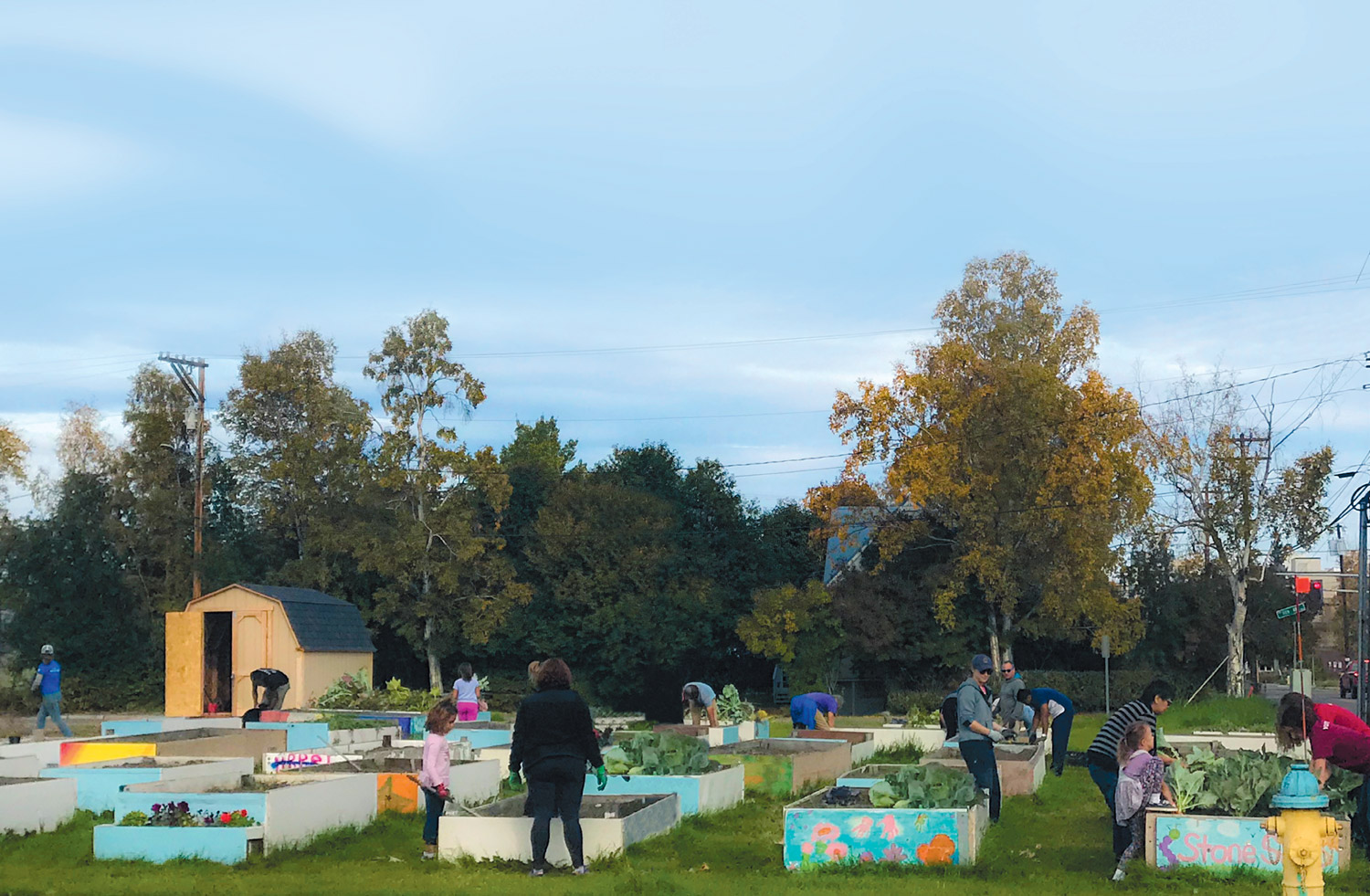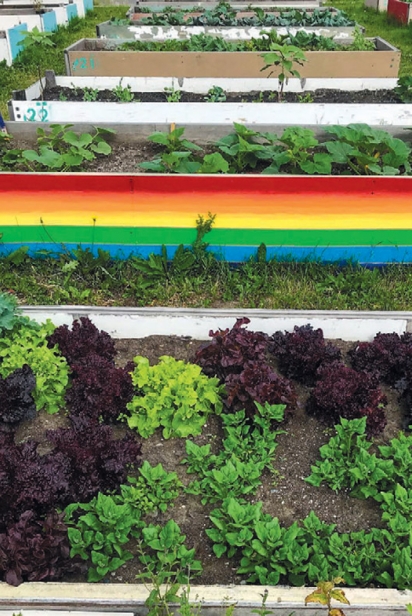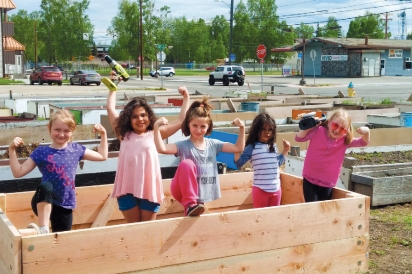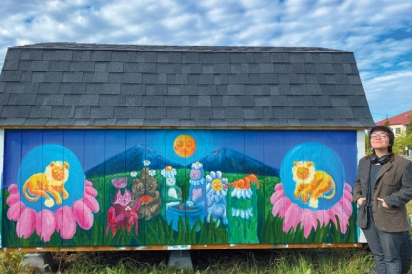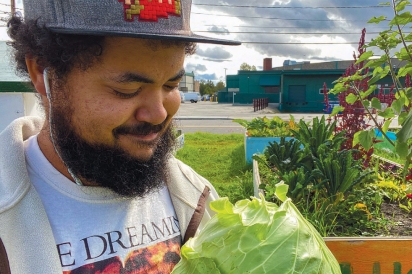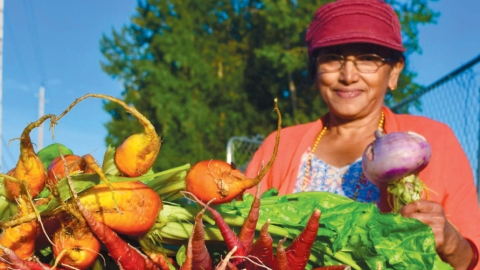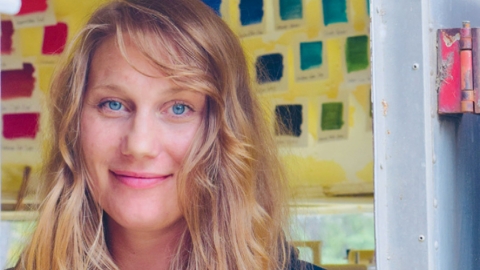Growing Food and Affirming Lives
Another summer starts with sunlight breaking through the blinds onto fledgling plants lining the windowsill of the Bread Line’s cramped office. Throughout May, community members come bearing more and more plants—brassicas, greens, tomatoes, squash, and so on. Until it’s warm enough to plant, I store them in whatever nooks and crannies are available in our little-soup-kitchen-that-could. During the day, I align them on the soil-filled bathtubs arranged around our exterior walls for short, gradual recesses where they slowly harden their resolve. A block away, more traditional garden beds soak up what remains of the melting snow, and I yank out the weeds that spring up from those puddles. From this routine, hopefully, food will grow.
Given that just this last year a cactus died under my watch, it still strikes me as odd that I am a caretaker of these plants and the garden they’ll soon inhabit. Thankfully, as the saying goes, it takes a village, and that of Fairbanks has helped my brown thumb gradually turn greener with each summer gardening under the midnight sun. Such is the foundation of community—individuals learning and growing together to ensure that those in need are nourished and full.
The garden lies tucked between the fire station and a few apartment complexes with more gravel than grass around the shed, battered pavilion, and 40 raised beds. No fence surrounds the garden and there’s not much signage, and so when I’m tending to the beds, passersby will sometimes ask, “Is this your garden?”
“This is the Stone Soup community garden,” I answer, and a community garden’s ownership can’t easily be reduced to who does the work.
The Bread Line, through its Stone Soup Cafe operation, has provided a warm, safe place for Fairbanks residents to receive a free hot meal since 1984. For the first 29 of its almost 40-year history, the café was a nomadic operation, feeding folks out of various church basements. Finally, in 2013, the Stone Soup Cafe settled into its downtown storefront space on Gaffney Road. Shortly after the café found a permanent home, the garden space followed, beginning as a few old bathtubs left behind the back of the kitchen. In those makeshift beds, the chefs grew some of their own herbs and veggies. However, in 2015, volunteers and then-board president, Sarah Stanley, aimed to expand the garden into the nearby vacant lot. Neighbors adjacent to the space suggested that the organization use it to grow more of its own food. Thanks to a generous $1-per-year lease offered by the Greater Fairbanks Community Hospital Foundation, the Bread Line made that suggestion a reality.
Helmed by volunteer-extraordinaire Micheline Patterson, about a dozen people helped clear the lot and erect 13 raised beds. As with the bathtubs behind the kitchen, upcycling—repurposing discarded items into something beautiful and useful—was important to the mission of these gardeners, and so, based on an idea that Patterson found online, volunteers built the beds out of old overhead garage doors. “It’s community revitalization,” Patterson told the Fairbanks Daily News-Miner at the time of the garden’s inception.
Revitalization indeed, and like the Stone Soup fable from which the café got its name, it is also a community collaboration. Every year since, local nurseries and farmers like Calypso Farm, Bender Mountain Farm, Holm Town Nursery, Risse Greenhouse, and individual growers have donated vegetables and flowers to fill those beds. Our garden provides a home for the misfit plants, those unbought or from carefully plotted gardens that lack room.
Though a few volunteers reserve their own beds to cultivate, the Stone Soup Garden is a communal space less in how the plot is managed and more in how the community invests in what grows there and whom it feeds. On the first Saturday of June, 30-some-odd volunteers descend upon the garden to transplant the donated seedlings. Old sourdoughs, college students, and local girl scout troops—among many others—dig their fingers into the dirt to begin the growing season. At planting day, we strive to plant whatever is offered. Though we harvest everything before the final frost, we make no qualms about who takes food and when. The food grown in our garden is a right to the people for which it’s grown.
All of that work has been done on the unceded lands of Lower Tanana Dene peoples. Our veggies grow because of the relationship cultivated by ancestral and present-day Indigenous Alaskans to this land. The Bread Line aims to feed and uplift vulnerable and actively oppressed populations, which largely include Alaska Natives. What the garden provides, then, is perhaps best described as stewardship. I try to listen to both the needs of the garden and those who receive nourishment from it, so that I may better serve the space and that the space might better serve its guests.
Many of the café’s guests enjoy their meals under the garden’s pavilion. Admittedly, I tend to work with headphones rattling from booming bass lines, but whenever I see guests nearby and strolling through the beds, I try and be more conscious of those around me. I try to talk to those who also daily interact with the garden. I try to listen and to learn.
My first summer in the garden I met a man who walked by every day, picked up trash, plucked a few weeds, and harvested a turnip fresh from the soil. “I’m just waiting for my sister to take me back to the village,” he’d told me. He was from Tanana, a village of about a couple hundred Athabascans located at the confluence of the Tanana and the Yukon River. The turnips, he said, reminded him of the ones his mother grew back home. Though the garden’s initial purpose was to grow food for the kitchen, I have noticed that many, like him, enjoy eating at the source. “Oh, these carrots taste just like the ones I grew!” I heard from another guest that same summer.
Bread Line Executive Director Hannah Hill has acknowledged this function too, and so the garden has shifted to meet that need. It’s just one of many ways the space communicates with us, and so we listen. This summer and last, we planted more root vegetable seeds— carrots, turnips, and radishes—as well as a few fruit bushes and snap peas that reach maturity quicker so that guests can pick and eat straight from the garden. The mission of the Bread Line is to affirm lives through food, and the eating garden allows for guests to recall their own roots. There’s something about a garden that makes any space—even a lot in the middle of downtown Fairbanks—feel like home, and so it receives the love a home deserves. The garden shed now has a pair of colorful murals courtesy of sister-artist-duo, Jessi and Kassi Saiki; funky street signs, like “Brassica Blvd” and “Field of Greens,” guide visitors through the plot; the Stone Soup Garden library invites guests to “take a book and leaf a book” for someone else to read; and each year, we look for more ways to make this plot more hospitable.
The garden began with a group of people who had a vision for an empty lot. It was all volunteer run then but has since evolved into a position for the Bread Line. Additionally, an AmeriCorps V.I.S.T.A. (Volunteers in Service to America) volunteer has joined the team in the last couple summers, and volunteers remain essential to and active in the growth of the garden. There’s the old idiom that too many cooks in the kitchen spoil the broth, but I have found that there’s always more room for gardeners in the yard.
A garden in the heart of downtown is its own boon as well as its own curse. There are, of course, days when it seems as if everything is conspiring against the plants, and by extension, their caretakers. Marmots, voles, aphids, vandals, and hailstorms have wreaked their havocs on the garden, and so it is with a spirit of tenacity and flexibility that one must approach the space. Some have suggested that a fence be built around the garden, but that seems counter to the openness and creativity with which the garden was first conceived. Still, through the help and advice of other local growers, we have met those challenges and continue to grow.
The garden has fared better than my ill-fated cactus. There are layers to growth, I’ve learned—not just what you grow in a season but how you build upon that growth. Fairbanks grants about 100 days to grow, and while we make the most of that time, I take more solace in the cycle itself. At the end of the summer, I compost the parts of the plants that can’t be cooked and cover the beds. How easily everything rots versus the labor it takes to cultivate those plants, and yet it’s easier still to harvest such growth—to pluck a plant from the ground and eat. Food is present at all stages of the process; fat, happy bacteria absorb nutrients into soil that will, in time, produce another turnip that tastes like home.


